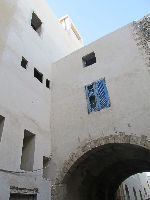|
Morocco:
West Atlas Bicycle Africa / Ibike Tours |
|||
 |
Atlantic Coast: South to Essaouira, Agadir | ||
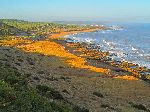
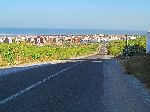
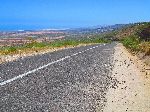
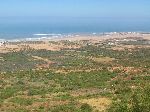 |
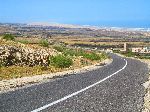 |
||
| From Safi to Essaouira, the road largely follows a Coastal ridge, broken by river valleys. One of the main detractors for this section is about have of the distance is paved by chip-seal, which creates a rough ride. The phase "broken by river valleys" signals some ups and downs, but there are long enough flat sections to find some rhythm at times. | |||
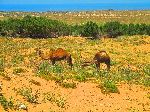
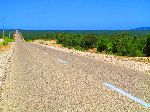
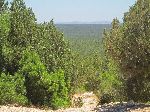 |
|||
| An interesting characteristic of the ecology is went from sand savannah to forest abruptly. The edge of the forest can be see behind the camels. The forest stretched for about 15km (10 miles). | |||
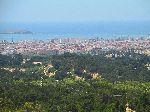 |
The
first view of Essaouira (pronounced "ṣ-Ṣwiṛa") is from a viewpoint on the highway that looks out over
the forest, town and ocean. There is a camel there to welcome guests. Until the 1960s, Essaouira was generally known by its Portuguese name, Mogador. This name might be a corruption of the older Berber name Amaqdūl that is mentioned by the 11th-century geographer al-Bakrī. Another explanation is during the Middle Ages, a Muslim saint named Sidi Mogdoul was buried in Essaouira, giving its the name "Mogador". |
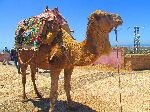 |
|
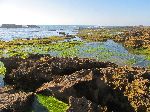 |
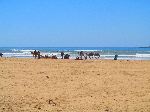 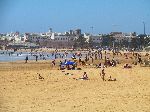 Essaouira
has a small cape, with a rocky beach on one side and the large sandy Plage
Tagharte (beach) on the other. Even on an off-season, mid-week day, there was a
good crowd on the beach and some people in the water. Essaouira
has a small cape, with a rocky beach on one side and the large sandy Plage
Tagharte (beach) on the other. Even on an off-season, mid-week day, there was a
good crowd on the beach and some people in the water.Among the amusements available were camel rides on the beach. |
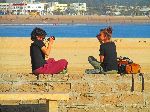 |
|
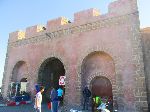
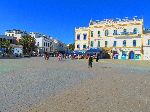
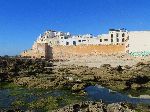
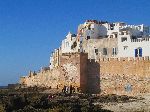 |
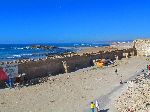 |
||
|
At the northeast, the entrance to Essaouira's old walled city is through Bab (gate) Doukkala, and at the southwest via Place Moulay el Hassan. Except at Place Moulay el Hassan the ramparts are intact (restored) and majestic. With in the walls are the Kasbah, Medina, Mellal (Jewish quarter) (Jews once represented 40% of the city's population), Cathedral, Mosques, and plenty of souks (markets). |
|||
| Long ago, just south of the current Place Moulay el Hassan, was Castelo Real of Mogador. It was constructed, in 1506, because of its location between Safi, an older Portuguese outpost and Agadir, which had just been established, in 1504. The building of the fortress was strongly opposed by local Berbers and Arabs. In mid-1510 it was taken over by Berbers, and in December 1510 the castle had to be abandoned and the garrison relocated at Safi. The Castelo Real was totally demolished in the 18th century following the plans to build the Essaouira city and fortifications by Sultan Sidi Mohammed ben Abdallah. The Sultan hired European consultants to construct a modern fortification. Originally called "Souira" ("the small fortress"), the name became "Es-Saouira" ("the beautifully designed"). | |||
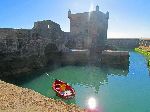
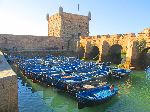
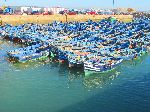
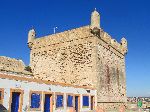 |
|||
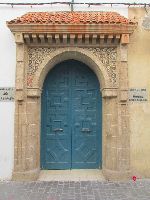 |
In place of Castelo Real of Mogador are the 18th-century fornications called the "Scala
del Mar" -- built by Genoese engineers. Though the name is unclear, scala
can mean ladder or staircase, in Italian. Part of the design of the Scala is arches, under which boats can pass, to be moored in a very protected harbor. From the time of its rebuilding by Muhammad III until the end of the nineteenth century, Essaouira served as Morocco's principal port, offering the goods of the caravan trade to the world. The route brought goods and slaves from sub-Saharan Africa to Timbuktu, then through the desert and over the Atlas mountains to Marrakech. The road from Marrakech to Essaouira is a straight line, explaining the king's choice of this port among the many that the Moroccan coast offers. During one period Essaouira was known as the "Port of Timbuktu." In the 19th century, Denmark, Britain, the Netherlands, France, Spain, Italy, Portugal and Brazil had consulates in Essaouira. |
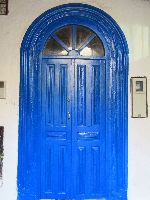 |
|
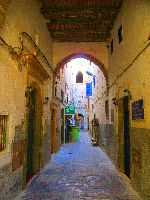
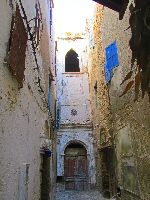 In a city of lobed arches, the gothic arch at the end of the alley is a signal
on something different. This guides the way to the now derelict, 18th century,
"Portuguese church."
In a city of lobed arches, the gothic arch at the end of the alley is a signal
on something different. This guides the way to the now derelict, 18th century,
"Portuguese church." |
|||
| By the start of the 19th century, the population of Essaouira was majority Jewish. There were as many as 40 synagogues. | |||
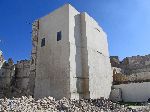 |
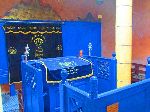
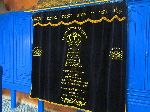
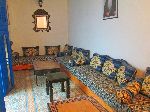
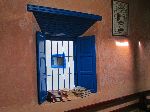 Most of the Mellah has crumbled. A prominent building that is being preserved is the house of Rabbi Hiam Pinto (1748–1845), a venerated rabbinical judge. It also served as his office, a synagogue and yeshiva (Jewish school). Although it looks very austere from the outside, there is open central column that pours natural light into much of the building. The building is open for visits. Of interest are the pulpit, men's worship room, women's worship room, sacred texts, and a still lit eternal light. Rabbi Pinto had four sons, and all followed in his footsteps. Rabbi Pinto is the focus of an annual pilgrimage to Essaouira that draws over a thousand participants. |
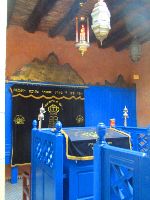 |
|
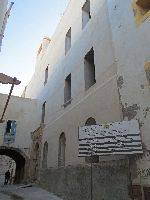 |
The Community Synagogue (Slat Lkahal Synagogue), Rue du Mellah, opened in 1850. It was crecently restored. There were several more synagogues on Rue du Murdoch - the spaces have now been transformed into alternative uses. |
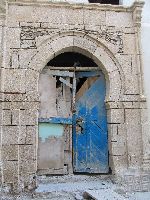 |
|
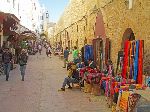
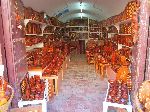
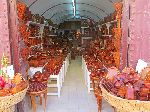 The
craft most closely associated with Essaouira is wood work. There are a dozen
wood craft sellers, and wood workshop, embedded in the west section of the city
wall. They all have a mix of wood boxes, bowls, platters, furniture, musical
instruments, household utensils and games board, by the thousands, for sale. The
craft most closely associated with Essaouira is wood work. There are a dozen
wood craft sellers, and wood workshop, embedded in the west section of the city
wall. They all have a mix of wood boxes, bowls, platters, furniture, musical
instruments, household utensils and games board, by the thousands, for sale. |
|||
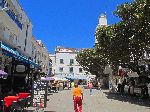
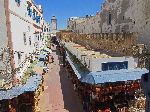
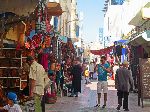
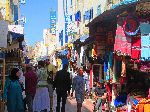 |
|||
| The old city has the usual shopping streets. The street culture was refreshingly laid back. When you tier of that it is easy to branching off into the labyrinthine side streets and alleyways. Unlike large medinas like Fes and Marakech, it is unlikely that one would get hopelessly lost, but it is large enough to have an hour of adventure. | |||
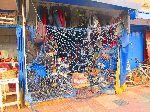 |
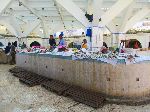 The
common method for a merchant to temporarily close their shop (as when going to
pray) is to hang a net across the front. (left) The
common method for a merchant to temporarily close their shop (as when going to
pray) is to hang a net across the front. (left)Essaouira fish market has an inventory that is fresh from the sea, but it still smells like a fish market. (right) An orderly, colorful and well labeled spice shop provides an eduations, as well as an excellent photo opportunity. (far right) |
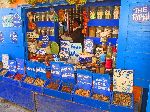 |
|
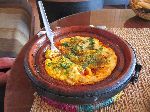 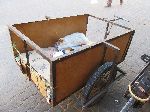 Essaouira
has a sizable Berber population. One of the benefits is Berber omelets. It has
some resemblance to huevos rancheros with green olives. Essaouira
has a sizable Berber population. One of the benefits is Berber omelets. It has
some resemblance to huevos rancheros with green olives.Moroccan cities are for cats. This one found a cart for his cat-nap. |
 |
||
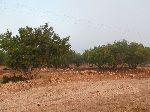
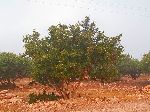
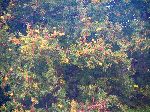
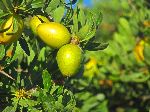 |
|||
In the region between Essaouira, Marrakech and Agadir there are approaching 20 million of
prickly-leafed Argan trees (above). They thrive in the arid climate where few
other plants could prosper. Argan oil is so versatile and valuable it’s likened
to ‘liquid gold’. With a wide variety of uses, both culinary and cosmetic, and a
long list of medicinal properties, the oil is an attractive commodity and the
rest of the world is catching on to its healing benefits. Exports more than
doubling between 2010-2015 to 700 tons. Even with increased supply, the increase
in demand pushed the wholesale price up to $20 a pound. Retail prices can exceed
10 times that amount. Stories, dating back to
the 13th century, explain that goats would eat the argan fruits,
locals later collecting their droppings to retrieve the argan nuts, which had
been conveniently softened by the animals’ stomach juices. This method saved on
labor by making the kernels easier to salvage, but the resulting oil had a
distinct stink to it. Today, argan oil production skips the goats’ intestines.
The work is done with the hands of tireless women. Argan nuts must be cracked
manually — attempts to mechanize the method have failed to keep the delicate
kernels intact. It takes 30kg of argan nuts, roughly the annual yield of one
tree and between 15 and 20 hours of hand processing to make 2 liters of cooking
oil or 1 liter of cosmetic oil. According to the International Development Research Centre (IDRC),
argan trees support the livelihoods of 3 million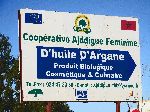 Moroccans, about 10% of the
country’s population, who use the husks as firewood, the fruit for animal fodder
and the pips to make precious oil. Argan oil is an important economy for locals
— particularly for women, who have grouped together to form more than 150
cooperatives. Argan oil has a
multitude of uses: it can be drizzled over salads, couscous and tagines to add a
nutty taste, applied as a scar healing, skin rejuvenating, nail strengthening
and hair vitality treatment and used medicinally as an anti-inflammatory and to
aid with immunity and blood circulation. No wonder Berbers call argan the ‘Tree
of Life.’ Moroccans, about 10% of the
country’s population, who use the husks as firewood, the fruit for animal fodder
and the pips to make precious oil. Argan oil is an important economy for locals
— particularly for women, who have grouped together to form more than 150
cooperatives. Argan oil has a
multitude of uses: it can be drizzled over salads, couscous and tagines to add a
nutty taste, applied as a scar healing, skin rejuvenating, nail strengthening
and hair vitality treatment and used medicinally as an anti-inflammatory and to
aid with immunity and blood circulation. No wonder Berbers call argan the ‘Tree
of Life.’ |
|||
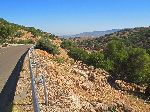
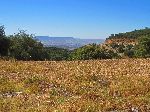
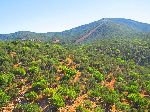
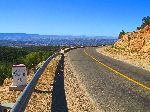 |
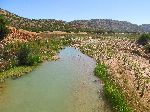 |
||
| Heading south from Smimou the climbs ridges and drops into river valleys and repeats. With each cycle the land gets increasing arid and the vegetation is more sparse and smaller, expect for a zone of forest, which extends more than ten kilometers to the east, and in the bottom lands next to rivers. | |||
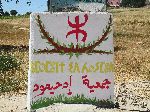 In the
western lowlands the number of Berber speaker increase significantly south of a
line between Essaouira and Marrakech, and extending hundreds of kilometers south
of Agadir. In this region there are many more signs using
Tifinagh script. Morocco
has three main groups of Berber. One, the Tarifit, are near the north coast, a
second, the Tamazights, is in and around the Atlas Mountains, and a third group, the
Tashelhiyt, which covers the whole of the Region Souss-Massa-Draâ, Errachidia
region and it’s also spoken in the Marrakech-Tensift-El Haouz region. In the
western lowlands the number of Berber speaker increase significantly south of a
line between Essaouira and Marrakech, and extending hundreds of kilometers south
of Agadir. In this region there are many more signs using
Tifinagh script. Morocco
has three main groups of Berber. One, the Tarifit, are near the north coast, a
second, the Tamazights, is in and around the Atlas Mountains, and a third group, the
Tashelhiyt, which covers the whole of the Region Souss-Massa-Draâ, Errachidia
region and it’s also spoken in the Marrakech-Tensift-El Haouz region. |
|||
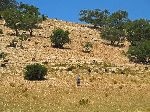
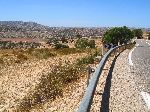
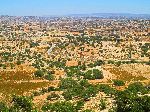
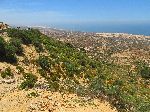 |
|||
|
As the climate becomes more arid, agriculture becomes more rare. The primary
economic activity is grazing, and that is restricted to goats.
The highest ridge is between Tamanar and Tamri, near Ait Oukkane and Afra. But the effort is not for nothing. |
|||
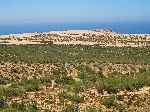
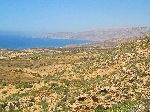
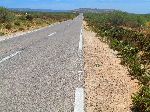 Once
you cross the ridge, there is a couple kilometers of winding descent, that drops
several hundred meters. Beside the descent the reward is spectacular views of
the coast and ocean at every turn. At the bottom the road flattens for the first
time is dozens of kilometers. If there is a tail wind, this is bliss. Once
you cross the ridge, there is a couple kilometers of winding descent, that drops
several hundred meters. Beside the descent the reward is spectacular views of
the coast and ocean at every turn. At the bottom the road flattens for the first
time is dozens of kilometers. If there is a tail wind, this is bliss. |
|||
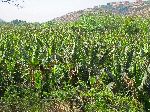
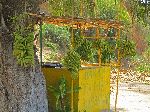 At
Tamri, the ridge move inland forming a flat horseshoe shaped valley, with the
Asif n-Srou (river) running through it. Ever indication is that this is an ideal
environment for bananas. The valley is filled with banana groves, there are
dozens of shops in town that are packed with bananas, and road side vendors sell
bananas. At
Tamri, the ridge move inland forming a flat horseshoe shaped valley, with the
Asif n-Srou (river) running through it. Ever indication is that this is an ideal
environment for bananas. The valley is filled with banana groves, there are
dozens of shops in town that are packed with bananas, and road side vendors sell
bananas. |
|||
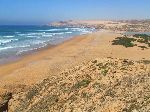
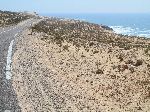
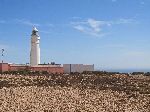
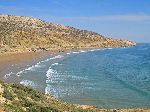 |
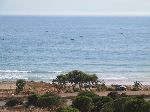 |
||
| From Tamri to the outskirts of Agadir there is more great coastal views. | |||
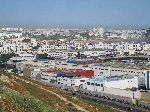
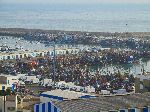 Agadir is an expansive town. A lot of it rich history had now been overwhelmed
by it current role as a destination resort town. There is some continuity in
architecture because a lot of the buildings are white, but in the potentially
most picturesque parts of town, a lot of these white buildings are tourist
hotels with hundreds of rooms, that obscure the views.
Agadir is an expansive town. A lot of it rich history had now been overwhelmed
by it current role as a destination resort town. There is some continuity in
architecture because a lot of the buildings are white, but in the potentially
most picturesque parts of town, a lot of these white buildings are tourist
hotels with hundreds of rooms, that obscure the views. |
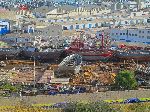 |
||
|
|
|||
|
|
Unique Programs To Special Places For Memories Of A Lifetime!
"Hosted by
DreamHost - earth friendly web hosting"
|
|
